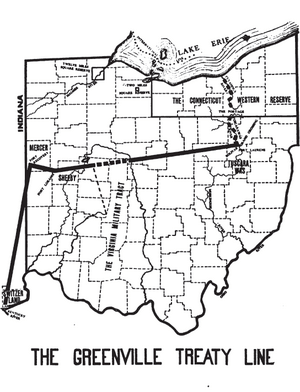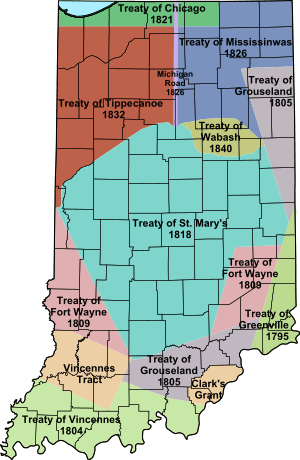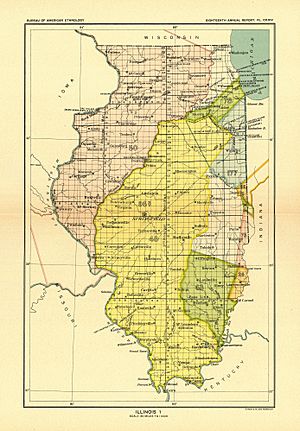List of treaties between the Potawatomi and the United States facts for kids
In the early 1800s, the United States of America government and the Potawatomi Native American tribe signed many important agreements. These agreements, called treaties, were mainly about the Potawatomi giving up their lands. The U.S. government wanted to buy these lands and end the tribe's ownership claims in the Northwest Territory. This was part of a bigger plan to move Native American tribes to new lands west of the Mississippi River.
Contents
Understanding the Treaties
The treaties between the U.S. and the Potawatomi were a big part of American history. They changed how land was owned and where people lived. These agreements often involved the Potawatomi giving up large areas of their traditional lands. In return, they sometimes received payments or other promises from the U.S. government.
Early Agreements (1789-1815)
Many early treaties involved several Native American tribes, including the Potawatomi. These agreements often aimed to establish peace or define land boundaries after conflicts.
- Treaty of Fort Harmar (1789): An early agreement involving several tribes.
- Treaty of Greenville (1795): This treaty set important land lines in Ohio and Indiana. It involved 11 tribes, including the Potawatomi, Shawnee, and Delaware.
- Treaty of Fort Wayne (1803): This agreement concerned lands around Vincennes, Indiana.
- Treaty of Vincennes (1804): This treaty added more land along the Ohio River.
- Treaty of Grouseland (1805): This agreement involved lands in Indiana.
- Treaty of Fort Wayne (1809): This treaty involved lands stretching towards Illinois.
- Treaty of Greenville (1814): This treaty brought peace and ended battles from the War of 1812.
- Treaty of Spring Wells (1815): This agreement officially ended the War of 1812 for many tribes.
Later Land Cessions (1816-1833)
After the War of 1812, more treaties focused on the U.S. gaining large amounts of land. The Potawatomi, often as part of the Council of Three Fires (a group of allied tribes), were involved in many of these.
- Treaty of St. Louis (1816): Another agreement involving the Council of Three Fires.
- Treaty of Miami Rapids (1817): This treaty involved lands south of the Maumee River.
- Treaty of St. Mary's (September 1818): This was a very important treaty. It involved a huge area of central Indiana, known as the "New Purchase."
- 1821 Treaty of Chicago: This agreement involved lands north of Lake Michigan's southern tip.
- Second Treaty of Prairie du Chien (1829): This treaty also involved the Council of Three Fires.
- 1833 Treaty of Chicago (1833): This was another significant treaty for the Council of Three Fires.
Treaties Specifically with the Potawatomi
Many treaties are often called the "Treaty with the Potawatomi," even if that wasn't their official name. These agreements specifically dealt with Potawatomi lands and rights.
- Treaty of Portage des Sioux (1815)
- Treaty of St. Mary's (October 1818)
- Treaty of Mississinewa (1826): This treaty involved lands north of the Wabash River.
- Treaty of St. Joseph (1827)
- Treaty of St. Joseph (1828)
- Treaty of Tippecanoe (October 20, 1832): This treaty involved lands in northwestern Indiana.
- Treaty of Tippecanoe (October 26, 1832): Another treaty concerning Potawatomi lands.
- Treaty of Tippecanoe (October 27, 1832): This agreement covered lands in north-central Indiana.
- Treaty of Maxeeniekuekee (1834)
- Treaty of Tippecanoe (1834)
- Treaty of Potawattimie Mills (1834)
- Treaty of Wabash (1834): This treaty involved a part of the Miami National Reservation.
- Treaty of Logansport (1834)
- Treaty of Turkey Creek Prairie (1836)
- Treaty of Tippecanoe (March 1836)
- Treaty of Tippecanoe (April 1836)
- Treaty of Logansport (April 22, 1836 a)
- Treaty of Logansport (April 22, 1836 b)
- Treaty of Yellow River (1836)
- Treaty of Chippewanaung (September 20, 1836)
- Treaty of Chippewanaung (September 22, 1836)
- Treaty of Chippewanaung (September 23, 1836)
- Treaty of Washington (1837)
- Treaty of the Wabash (1840): This treaty ended the Miami National Reservation.
- Treaty of Potawatomi Creek (1846): This involved the Council of Three Fires and the Potawatomi.
- Treaty of Shawnee Reserve (1861)
- Treaty of Washington (1866)
- Treaty of Washington (1867)
These treaties show a long period of land changes and agreements between the U.S. government and the Potawatomi people.




